August 6, 2025 | by Rayhan
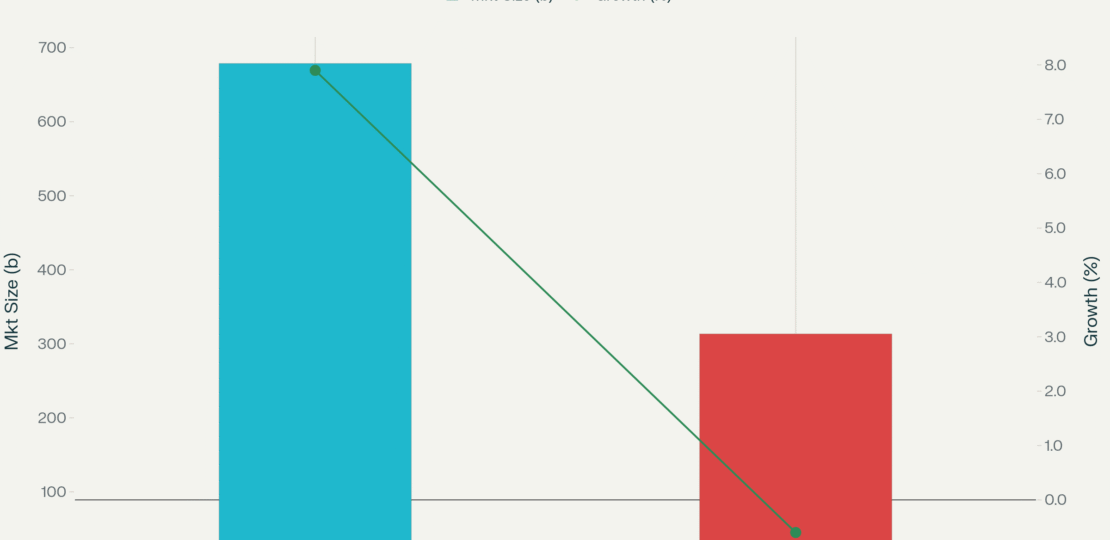
Digital Marketing vs Traditional Marketing isn’t just a comparison—it’s the strategic crossroads where businesses decide how to thrive. Imagine launching a campaign that gives you instant analytics, precision targeting, and flexibility to pivot—while another spends weeks producing a glossy print ad missing measurable impact. In 2025, savvy brands are writing their success stories by weaving both voices—digital’s data-driven agility with traditional marketing’s trust and reach—into a narrative that engages, converts, and resonates.
The marketing landscape has undergone a seismic shift over the past two decades, with digital channels now commanding 72.7% of global advertising investment, surpassing $790 billion in 2024. As we advance into 2025, the debate between digital and traditional marketing has evolved from a simple either-or choice to a strategic decision about resource allocation and audience engagement. This comprehensive analysis reveals why understanding both approaches—and their optimal integration—has become critical for business success.
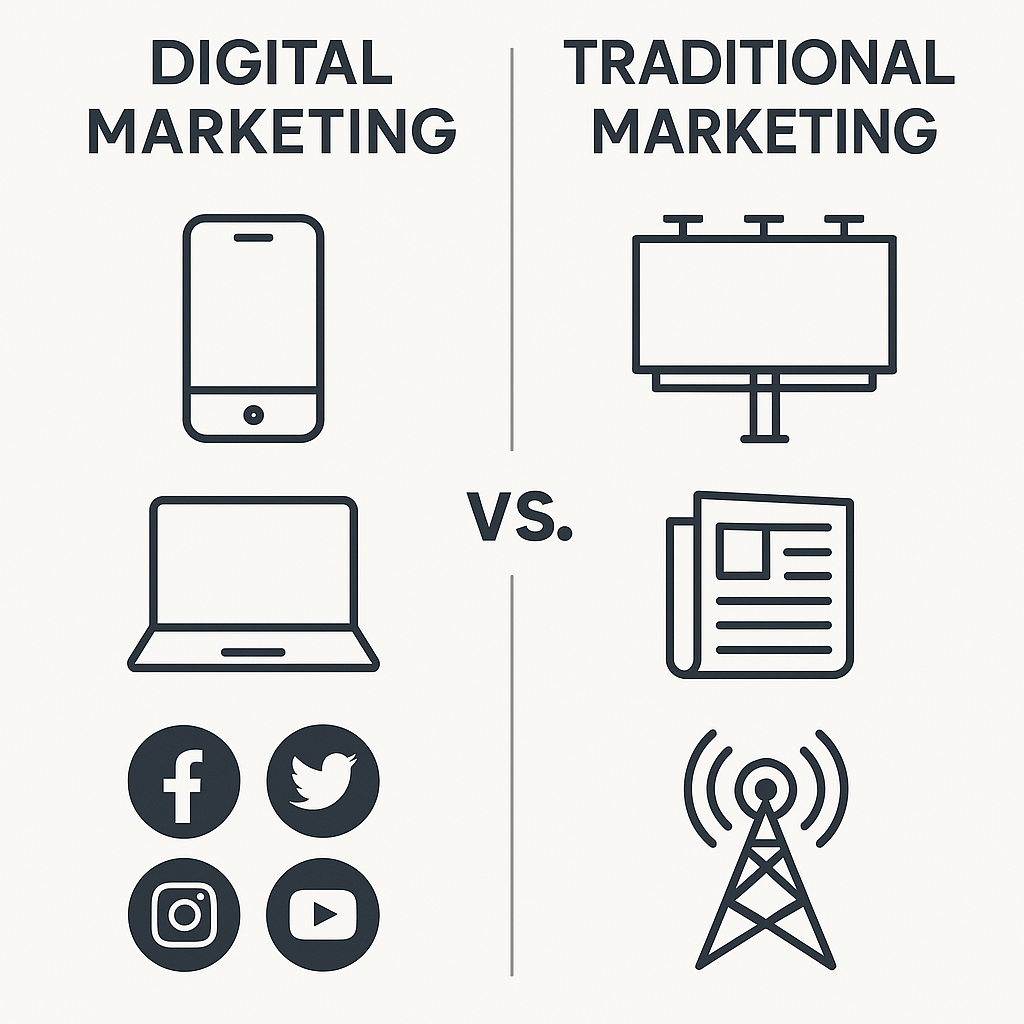
Digital vs Traditional Marketing Visual Comparison
The financial data presents a compelling picture of the marketing industry’s direction. Digital marketing has achieved unprecedented scale, with projections indicating the global digital advertising market will reach $843 billion in 2025. This represents a 10.3% year-over-year growth, demonstrating the channel’s robust expansion despite economic uncertainties.
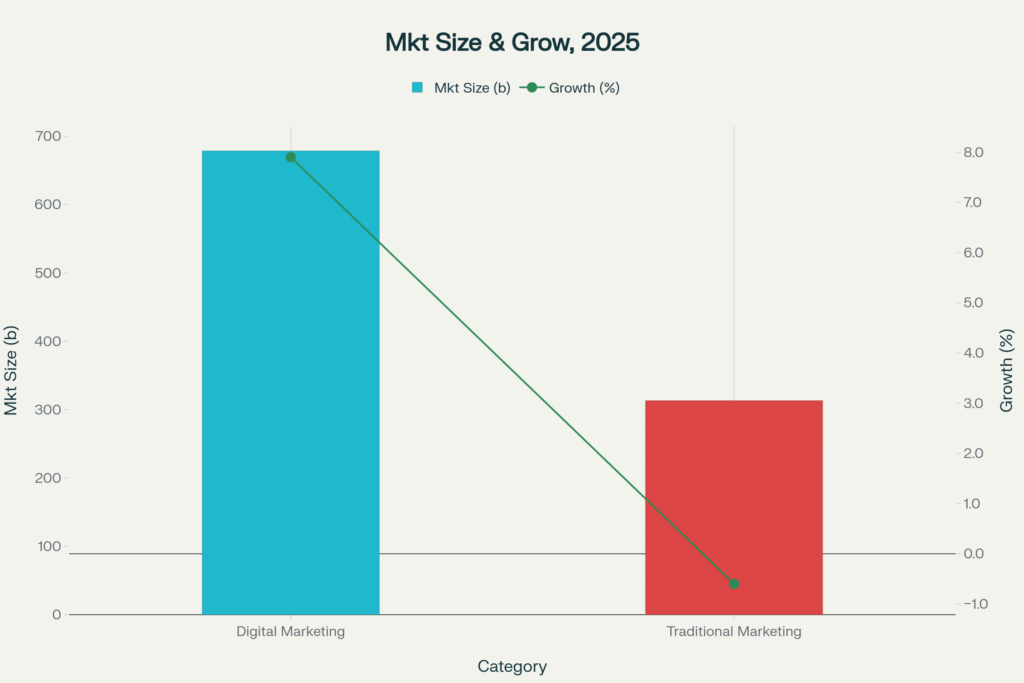
Digital vs Traditional Marketing: 2025 Market Size and Growth Comparison
Traditional marketing, while maintaining significance, tells a different story. The traditional advertising sector accounts for approximately $313.3 billion globally, experiencing a 0.6% decline in spending according to recent CMO surveys. This divergence highlights a fundamental shift in how businesses allocate their marketing resources.
Research from 2025 reveals that 50.8% of consumers now prefer digital marketing formats compared to 28.4% who favor traditional media. This preference shift isn’t merely generational—it reflects changing consumption patterns across all demographics. Contrary to common assumptions, age showed no significant correlation with advertising preferences, suggesting that digital adoption has become universal rather than age-specific.
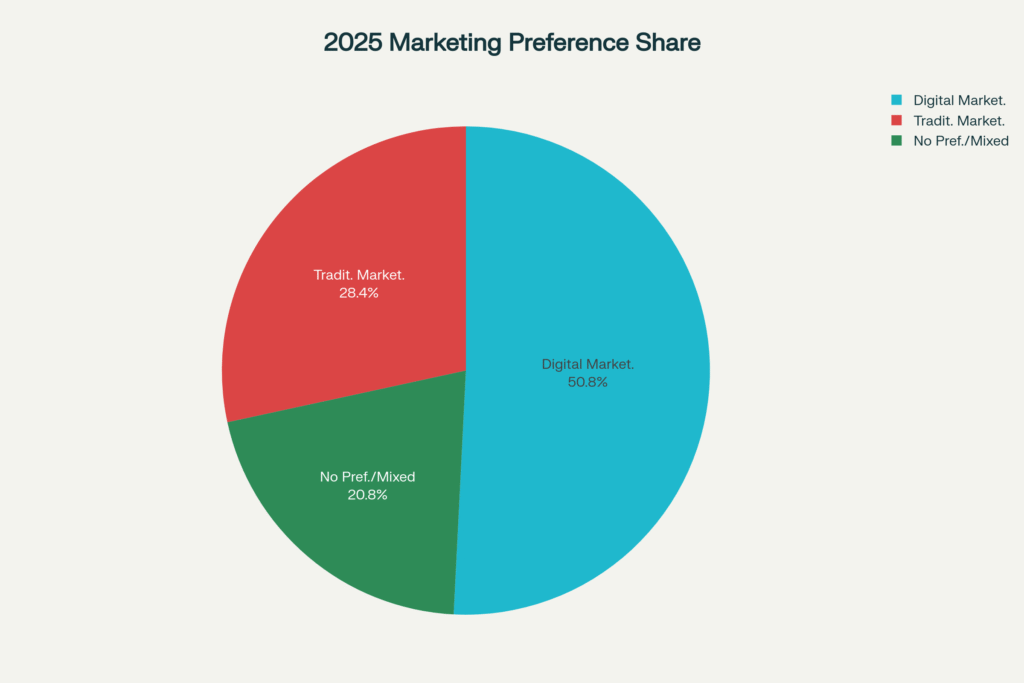
Consumer Marketing Preferences in 2025
The data challenges traditional demographic targeting assumptions. Instead of relying on age-based segmentation, successful marketers in 2025 focus on behavioral patterns, platform usage, and engagement preferences to reach their audiences effectively.
Digital marketing’s financial performance significantly outpaces traditional methods across multiple channels. The return on investment data reveals striking differences:
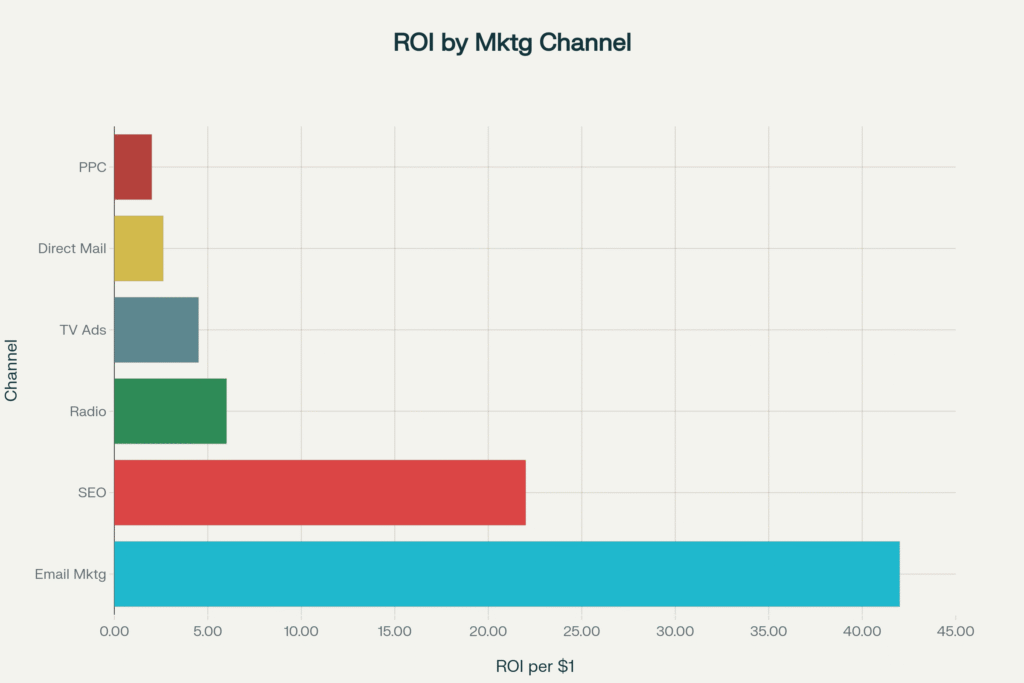
Marketing Channel ROI Comparison: Return per Dollar Invested
Email marketing leads the pack with an extraordinary $42 return for every dollar invested, representing a 4,200% ROI. This performance stems from email’s ability to deliver personalized, targeted content at minimal marginal cost while maintaining direct communication with opted-in audiences.
Search Engine Optimization (SEO) delivers $22 per dollar spent, achieving a 2,200% ROI. This exceptional return reflects SEO’s compound benefits—once optimized content begins ranking, it continues generating traffic without additional media spend, creating long-term value that traditional advertising cannot match.
Pay-Per-Click (PPC) advertising provides a more modest but still impressive $2 return per dollar, representing a 200% ROI. While lower than email and SEO, PPC offers immediate results and precise audience targeting that traditional media struggles to achieve.
Digital marketing’s targeting accuracy has reached 85% precision, compared to traditional TV advertising’s 36% accuracy. This improvement directly impacts campaign efficiency and cost-effectiveness. AI-powered advertising platforms can now identify and reach specific audience segments based on behavioral data, purchase history, and real-time interactions.
The measurement capabilities distinguish digital marketing most clearly from traditional approaches. Digital campaigns provide real-time analytics, allowing marketers to track every interaction, optimize performance instantly, and calculate precise attribution. This transparency enables data-driven decision-making that traditional marketing cannot offer.
Digital marketing’s budget flexibility represents a crucial advantage for businesses of all sizes. Companies can begin campaigns with as little as $5 and scale to $30,000+ monthly, adjusting spend based on performance. This scalability allows small businesses to compete effectively while enabling large enterprises to optimize resource allocation dynamically.
The average cost per acquisition (CPA) across all industries stands at $59.18 for digital campaigns, with significant variation by sector. E-commerce businesses achieve particularly efficient acquisition costs at $45.27 for search campaigns, while technology companies face higher CPAs at $133.52, reflecting competitive keyword markets.
Despite digital’s dominance, traditional marketing retains specific advantages that make it valuable in integrated strategies. Television advertising continues delivering strong ROI at $4-5 per dollar invested, particularly effective for building brand awareness and reaching broad audiences during major events.
Radio advertising achieves impressive $6 per dollar spent returns, especially in local markets where it maintains captive audiences during commute times. This performance reflects radio’s ability to reach consumers during high-attention moments when they’re receptive to messaging.
Direct mail to house lists generates the highest ROI among traditional channels at $2.61 per dollar spent (161% ROI). The tangible nature of physical mail creates memorable brand interactions, with 80-90% open rates compared to email’s 20-30% average. This tactile advantage becomes particularly valuable for high-value offers or relationship-building communications.
Traditional marketing maintains higher perceived credibility among consumers. Research indicates that 82% of consumers find print ads more trustworthy than digital ads. This trust factor becomes crucial for industries where credibility directly impacts purchase decisions, such as healthcare, financial services, and luxury goods.
The permanence and production values associated with traditional media contribute to this perception. A full-page magazine advertisement or television commercial signals significant brand investment, creating implicit quality associations that some digital formats struggle to match.
Traditional marketing excels in local targeting, particularly for businesses serving specific geographic regions. Outdoor advertising (billboards, signage) and local radio sponsorships provide location-based relevance that digital targeting is only beginning to match effectively.
Local newspapers and community publications offer contextual relevance for regional businesses, while event marketing and sponsorships create face-to-face connections that digital channels cannot replicate. These interactions build deeper relationships and community trust that translate into long-term customer loyalty.
Digital marketing’s ability to deploy campaigns instantly and optimize in real-time provides an insurmountable advantage in fast-moving markets. Search campaigns can be launched within hours, while social media content can respond to trending topics or breaking news immediately.
Traditional campaigns require weeks or months for development, production, and distribution. Once launched, modifications necessitate additional investment and extended timelines. This inflexibility becomes particularly problematic during market volatility or competitive responses.
AI-powered personalization enables digital marketing to deliver individualized experiences at scale. Modern platforms can customize content, timing, and channel selection based on real-time behavioral data, creating unique customer journeys for each prospect.
Traditional marketing relies on broad demographic segmentation, limiting personalization to basic audience categorization. While this approach works for mass-market products, it cannot match digital’s granular customization capabilities.
Digital marketing facilitates two-way communication, enabling immediate feedback, social sharing, and community building. Interactive content formats—polls, quizzes, live streams—create engaging experiences that encourage active participation.
Traditional marketing primarily offers one-way communication, limiting audience engagement to passive consumption. While this approach works for awareness building, it cannot foster the interactive relationships that drive modern customer loyalty.
Current data reveals that 30.6% of total marketing budgets are allocated to paid media in 2025, with the majority directed toward digital channels. Email marketing requires minimal ongoing investment (typically $51-$1,000 monthly for most businesses), while delivering exceptional returns.
SEO investments range from $500-$7,500 monthly for 68% of businesses, representing long-term value creation rather than immediate expense. This investment model contrasts sharply with traditional advertising, which requires continuous spending to maintain visibility.
Traditional marketing demands significant upfront investments with uncertain returns. A single magazine advertisement can cost $120,000, while television commercials require both production expenses and airtime purchases. These barriers exclude many small businesses from traditional advertising entirely.
Digital marketing’s flexible cost structures enable businesses to start small and scale based on results. Social media advertising and content marketing can generate meaningful results with modest budgets, democratizing access to effective marketing tools.
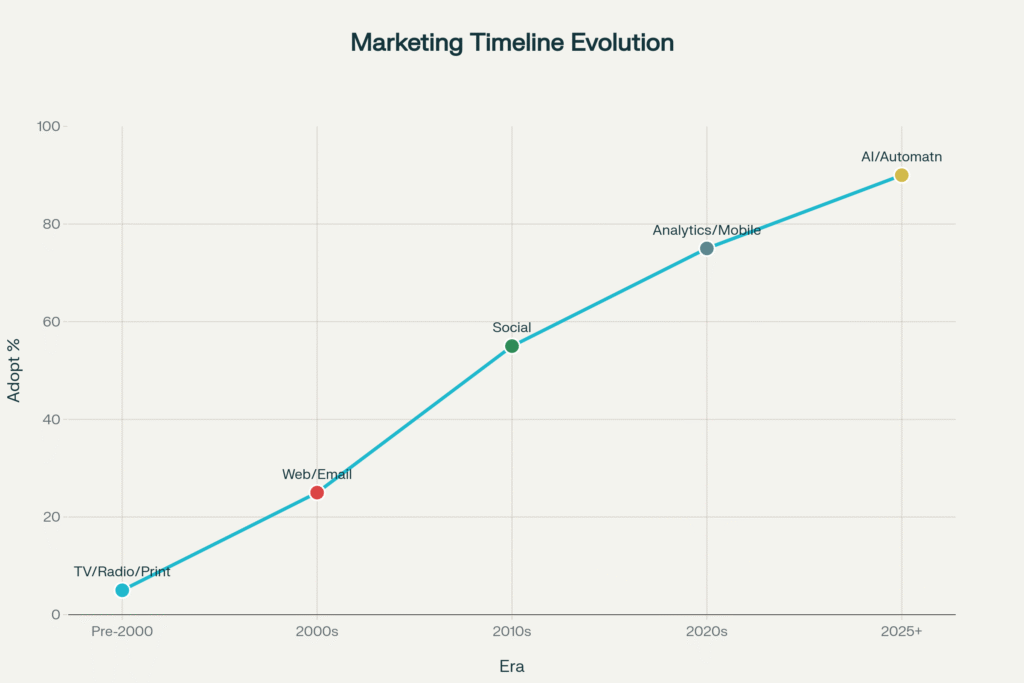
Marketing Evolution Timeline: From Traditional to AI-Powered Digital
The most successful marketing strategies in 2025 combine both approaches strategically. Integrated marketing campaigns that align digital and traditional touchpoints achieve 23% higher conversion rates than siloed efforts. This synergy creates multiple impression points that reinforce messaging and increase brand recall.
Cross-channel attribution reveals how traditional advertising influences digital engagement. Billboard campaigns can drive search volume increases, while radio sponsorships boost website traffic and social media engagement. Understanding these interconnections enables more sophisticated campaign planning and budget optimization.
The lines between digital and traditional channels continue blurring as platforms expand capabilities. Television broadcasters integrate social media elements, while digital platforms explore offline advertising opportunities. This convergence creates new opportunities for seamless customer experiences across all touchpoints.
QR codes on traditional advertisements bridge offline and online experiences, enabling immediate digital engagement from traditional media exposure. Similarly, location-based digital advertising can complement outdoor campaigns for comprehensive local market coverage.
AI-powered marketing automation is revolutionizing both digital and traditional campaign development. 77% of marketers now use AI for personalized content creation, while predictive analytics inform media buying decisions across all channels.
The marketing automation market is projected to reach $15.62 billion by 2030, growing at 15.3% annually. This growth reflects increasing sophistication in automated campaign management, lead nurturing, and customer journey optimization.
First-party data collection becomes increasingly critical as third-party cookies disappear. This shift affects digital marketing’s targeting capabilities while potentially benefiting traditional media that relies less on personal data for effectiveness.
Privacy regulations create opportunities for traditional marketing’s broad-reach approach, which doesn’t depend on individual tracking. However, this also limits digital marketing’s personalization advantages, potentially leveling the competitive playing field.
Consumer preferences increasingly favor sustainable marketing practices and authentic brand communications. 57% of consumers express willingness to pay more for eco-friendly products, influencing both traditional and digital campaign development.
User-generated content and influencer partnerships provide authentic alternatives to traditional advertising, while programmatic advertising reduces waste in traditional media buying. These trends reflect broader consumer desires for genuine, responsible brand interactions.
Businesses should evaluate channel selection based on specific objectives rather than universal preferences. Brand awareness campaigns may benefit from traditional media’s broad reach, while conversion-focused efforts achieve better results through digital channels’ precision targeting.
Customer lifetime value calculations should inform channel investment decisions. High-value customers may justify traditional marketing’s higher costs, while volume-based businesses benefit from digital marketing’s cost efficiency and scalability.
Implement comprehensive attribution models that account for cross-channel influences. Traditional advertising’s brand-building effects may not generate immediate digital conversions but create long-term value that single-touch attribution models miss.
Marketing mix modeling provides insights into traditional marketing’s contribution to overall business results, while digital analytics offer granular performance data. Combining these approaches creates a complete picture of marketing effectiveness.
Progressive budget shifting toward digital channels should be based on performance data rather than industry trends. Some businesses may find traditional marketing still delivers superior results for their specific markets and objectives.
Testing and optimization should guide resource allocation decisions. A/B testing digital campaigns alongside traditional media experiments provides empirical evidence for budget optimization rather than relying on assumptions or best practices.
The marketing landscape of 2025 rewards strategic thinking over dogmatic adherence to either digital or traditional approaches. While digital marketing offers superior measurement, targeting, and cost efficiency for most applications, traditional marketing retains valuable strengths in trust-building, local presence, and broad awareness generation.
Success requires understanding each approach’s unique advantages and integrating them strategically based on business objectives, target audiences, and market conditions. The businesses that thrive will be those that leverage data to make informed channel decisions rather than following universal prescriptions.
As artificial intelligence, privacy regulations, and consumer preferences continue evolving, marketers must remain adaptable and evidence-based in their approach. The future belongs not to digital or traditional marketing exclusively, but to integrated strategies that harness the best of both worlds to create exceptional customer experiences and measurable business results.
The choice between digital and traditional marketing is no longer binary—it’s strategic. Organizations that recognize this distinction and act accordingly will capture the greatest opportunities in our rapidly evolving marketing landscape.
View all